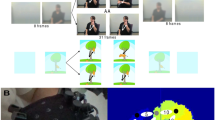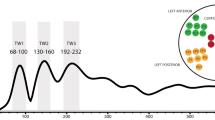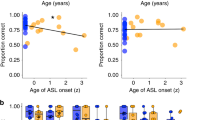Abstract
THE left cerebral hemisphere is dominant for language, and many aspects of language use are more impaired by damage to the left than the right hemisphere. The basis for this asymmetry, however, is a matter of debate; the left hemisphere may be specialized for processing linguistic information1–3 or for some more general function on which language depends, such as the processing of rapidly changing temporal information4 or execution of complex motor patterns5. To investigate these possibilities, we examined the linguistic abilities of 23 sign-language users with unilateral brain lesions. Despite the fact that sign language relies on visuo-spatial rather than rapid temporal information, the same left-hemispheric dominance emerged. Correlation analyses of the production of sign language versus non-linguistic hand gestures suggest that these processes are largely independent. Our findings support the view that the left-hemisphere dominance for language is not reducible solely to more general sensory or motor processes.
This is a preview of subscription content, access via your institution
Access options
Subscribe to this journal
Receive 51 print issues and online access
$199.00 per year
only $3.90 per issue
Buy this article
- Purchase on Springer Link
- Instant access to full article PDF
Prices may be subject to local taxes which are calculated during checkout
Similar content being viewed by others
References
Bellugi, U., Poizner, H. & Klima, E. Trends Neurosci. 10, 380–388 (1989).
Corina, D. P., Jyotsna, V. & Bellugi, U. Science 255, 1258–1260 (1992).
Poizner, H., Klima, E. S. & Bellugi, U. What the Hands Reveal About the Brain (MIT Press, Cambridge, MA, 1987).
Tallal, P., Miller, S. & Fitch, R. H. Ann. N.Y. Acad. Sci. 682, 27–47 (1993).
Kimura, D. Neuromotor Mechanisms in Human Communication (Oxford Univ. Press, 1993).
Newport, E. & Meier, R. in The Crosslinguistic Study of Language Acquisition Vol. 1. The Data (ed. Slobin, D. I.) (Lawrence Erlbaum, Hillsdale, NJ, 1985).
Corina, D. & Sandler, W. Phonology 10, 165–207 (1993).
Perlmutter, D. M. Linguistic Inquiry 23, 407–442 (1992).
Klima, E. & Bellugi, U. The Signs of Language (Harvard Univ. Press, Cambridge, MA, 1979).
Lillo-Martin, D. Universal Grammar and American Sign Language: Setting the Null Argument Parameters (Kluwer Academic, Boston, MA, 1991).
Lillo-Martin, D. & Klima, E. S. in Theoretical Issues in Sign Language Research Vol 1. Linguistics (eds Fischer, S. D. & Siple, P.) 191–210 (Univ. Chicago Press, 1990).
Liddell, S. American Sign Language Syntax (Mouton, New York, 1980).
Corina, D. P. in Phonetics and Phonology: Current Issues in ASL Phonology (ed. Coulter, G. R.) 63–95 (Academic, New York, 1993).
Chiarello, C., Knight, R. & Mandel, M. Brain 105, 29–51 (1982).
Poizner, H. & Kegl, J. Ann. N.Y. Acad. Sci. 682, 192–213 (1993).
Goodglass, H. & Kaplan, E. The Assessment of Aphasia and Related Disorders. (Lea & Febiger, Philadelphia, 1976).
Kimura, D. Phil. Trans. R. Soc. Lond. B298, 135–149 (1982).
DeRenzi, E. & Vignolo, L. A. Brain 85, 665–678 (1962).
Osterrieth, P. A. Archs. Psychol. 30, 206–356 (1944).
Author information
Authors and Affiliations
Rights and permissions
About this article
Cite this article
Hickok, G., Bellugi, U. & Klima, E. The neurobiology of sign language and its implications for the neural basis of language. Nature 381, 699–702 (1996). https://doi.org/10.1038/381699a0
Received:
Accepted:
Issue Date:
DOI: https://doi.org/10.1038/381699a0
This article is cited by
-
Shared neural correlates for building phrases in signed and spoken language
Scientific Reports (2018)
-
Patterns of non-verbal social interactions within intensive mathematics intervention contexts
Mathematics Education Research Journal (2016)
-
Dissociating cognitive and sensory neural plasticity in human superior temporal cortex
Nature Communications (2013)
-
Asymmetrical hippocampal connectivity in mesial temporal lobe epilepsy: evidence from resting state fMRI
BMC Neuroscience (2010)
-
Dynamics of hemispheric specialization and integration in the context of motor control
Nature Reviews Neuroscience (2006)
Comments
By submitting a comment you agree to abide by our Terms and Community Guidelines. If you find something abusive or that does not comply with our terms or guidelines please flag it as inappropriate.



